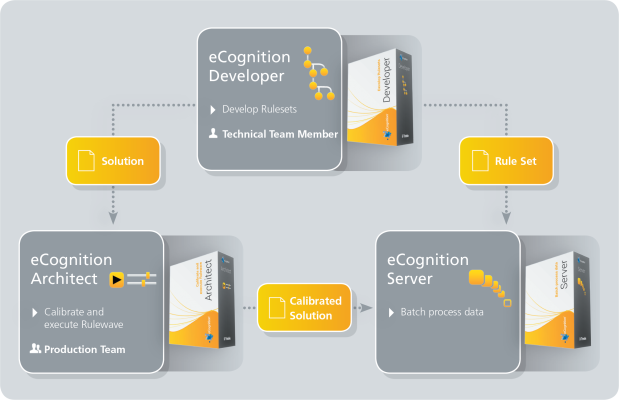Overview
Key Features
- Easy-to-use graphic representation of the analysis workflow
- Solution Builder enables new workflows to be configured easily from components
- Calibration of the application to the specific image analysis conditions is easy with simple graphical controls or sample-based training
- Tailored views for managing data, executing applications and viewing results
- Flexible multi-dimensional data import
- Batch processing with the eCognition Server
- Integrated multi-dimensional data import
- Sophisticated 3D visualization of results
- 3D and time series data views.

Benefits
- Supports a complete range of multi-dimensional image analysis applications
- Analysis workflows are easy to use, even for users with little experience
- Applications can be calibrated for specific image conditions without technical knowledge
- New workflows can be rapidly configured from reusable building blocks
- Supports fully automated and semi-automated workflows
- Batch processing with the eCognition Server increases sample sizes and speeds up results.

eCognition Architect Action library - Analysis builder
eCognition Architect Differences
eCognition Architect provides the following additional capabilities for end-users running multidimensional image analysis applications:
- Flexible import of multi-dimensional image data
- New connectors
- Intuitive viewer for multi-dimensional data.
Flexible Import of Multi-Dimensional Image Data
DICOM support is provided for medical imaging formats and including common modalities such as CT, MRI and PET data. Metadata is extracted from the DICOM images and can be used to control the analysis process.
A powerful generic import tool is provided to enable the import of multi-dimensional image data from a sequence of files and folders in a range of common image formats.
A fully multi-dimensional data model supports 2D, 2D time series, 3D and 3D time series data.
Intuitive Viewer for Multi-Dimensional Data
An integrated viewer enables users to examine single or multiple Architect images side by side. Three different projections of the image can be displayed – XY, XZ, and ZY. View settings can be synchronized and objects picked from these displays. Time series data can be viewed in movie mode.
Sophisticated 3D Visualization
Each eCognition client incorporates a sophisticated 3D visualization environment. This provides an intuitive environment for reviewing results and developing new image analysis applications.
Visualization functionality includes surface rendering of classified objects, object selection, OpenGL hardware acceleration, rotation, class display and transparency selection.
